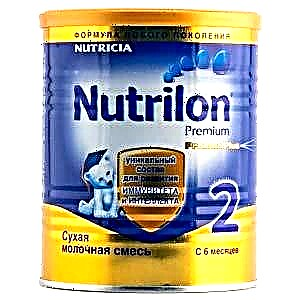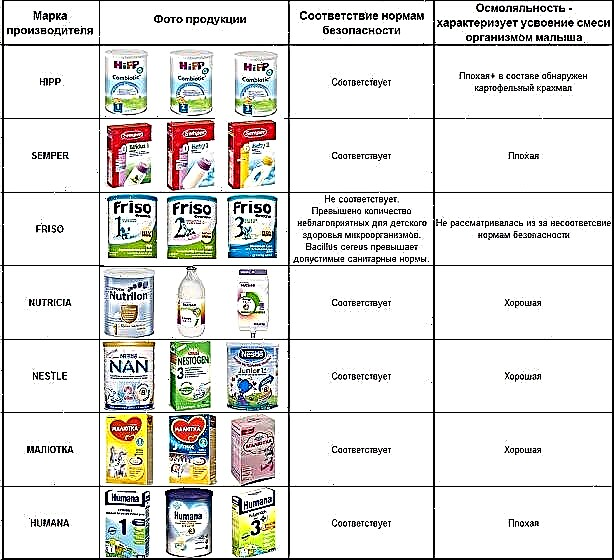Breastfeeding experts confidently state that any woman can breastfeed a baby. However, sometimes the desire to feed the baby stumbles upon serious obstacles. The main obstacle to breastfeeding is diseases for which treatment is not compatible with HB. Sometimes, having started successfully, breastfeeding ends in a few months due to the fact that the mother was unable to establish lactation and correctly organize the feeding process. There are times when a mother, due to her own views and beliefs, does not at all try to breastfeed the baby, giving a mixture from birth. In all these cases, the child grows up on artificial feeding. It is important for parents to figure out what are the mixtures for newborns in terms of their composition and properties. The fact is that feeding a baby at an early age is a guarantee of his health for the future. Of course, nothing can be better than mother's milk, but if, for some reason, the child will grow up on artificial feeding, the choice of a formula for nutrition must be approached very thoroughly.

Types of mixtures: we study and classify
The baby food market has a wide range of varieties of infant formula, which are coordinated with the requirements of GOST and the Institute of Nutrition. It is very easy to get confused in the variety of multi-colored jars and boxes with infant formula. Therefore, for a start, we propose to figure out who is who on the store shelf and what the numbers and inscriptions on the packages with the mixture mean. In other words, let's consider what kind of infant formula are in terms of consistency, composition, age and purpose.
Consistency
According to the consistency, infant formula can be divided into dry and liquid.
- Dry mixes. On the Russian market, this is 90% of infant formula. Such mixtures are powder packed in a cardboard box or tin can, which must be diluted with boiled water before use.
- Liquid. Such mixtures are already ready for use and only require heating. They are sold in tetrapack packages and packaged in 200 ml. The only problem is that the share of such mixtures in Russian stores is negligible. You can find such mixtures only in large cities.
The most common are dry, they are easy to store, dispense, easy to transport and have a wide variety of choices. Liquid mixtures are easier to prepare than dry ones, as they only need heat. But they have a short shelf life (only a couple of days).

Composition
Almost all milk formulas are made on the basis of cow's milk. Since cow's milk protein is foreign to our body, it must be present in the mixture in a modified form. Depending on the degree of processing of milk protein, infant formula can be divided into:
- Adapted. They are made on the basis of demineralized whey of cow's milk, therefore, such mixtures are as close as possible to breast milk in their properties. They are light enough, nutritious, and quickly absorbed. The adapted formulas are designed just for newborns. In addition to demineralized whey, the adapted mixtures include polyunsaturated fatty acids, vitamins, minerals, nucleotides. Of course, such mixtures are more expensive to manufacture, therefore, by price, they can be attributed to the premium class. The most popular adapted blends are:
- Nestle NAN (the cost is about 400-500 rubles for a package of 400 grams, depending on the availability of additional components);
- Nutricia Nutrilon (prices range from 375 to 650 rubles per 400gr);
- Semper (sold in packs of 350g, price range 360-480r.);
Some babies have a problem with cow's milk protein intolerance, so whey-based formulas are not suitable for them. For these children, there are adapted milk formulas based on goat milk:
- Bibicol Nanny (400gr packaging costs about 1300r.);
- Partially adapted to some extent, structurally similar to breast milk, they include not only lactose, but also sucrose in their composition, they do not have a stabilized mineral and fat composition;
- Subsequent are made from powdered whole cow's milk, to which sucrose and starch are added, they do not contain whey.
Depending on the child's age:Up to 6 months - starting, and over six months - subsequent.
Liquid mixtures are also adapted. The most accessible of them are:
- Ready-made milk formula NAN (price about 60 rubles for a package of 200 ml)
- Ready-made milk mixture Agusha (price about 25 rubles for a package of 200 ml)

- Unadapted. These mixtures are made on the basis of cow's milk protein - casein. As additional components, they can contain everything that is available in the adapted mixtures. There are mixtures that are very "poor" in composition: they lack taurine and fatty acids. On this basis, in some sources, unadapted infant formula divided into "less adapted" (casein instead of demineralized whey, the rest of the components as in adapted mixtures) and "partially adapted" (casein and a poor composition of additional components). This is not entirely correct, because the degree of adaptability of the mixture is determined by how easily the mixture is absorbed by the child's body, and this depends precisely on what is present in it as a milk base: demineralized whey or cow's milk protein. Casein mixes, regardless of their nutritional value, are harder to digest, so they are all unadapted anyway, and should only be given after 6 months. The main "representatives" of casein mixtures are:
- Similac (price from 350 to 650 rubles for a standard package);
- Nestle Nestogen (packaging weighing 370g is sold for an average of 240 rubles);
- Baby (price per package is about 210 rubles).

As a child grows, his digestive system develops. If for a newborn, formulas based on demineralized whey are better suited, then for children over six months, you can use casein formulas or formulas, the milk base of which is powdered cow's milk (these are mixtures of the second and subsequent levels).
Age indicator
The formula for infant formula is highly dependent on the age of the baby for whom it is intended. This is due to the fact that as the child grows and develops, the child's digestive system improves and the body's needs for nutrients change. This is a completely natural process, because breast milk also changes its composition with the growth of the baby. The formula number of the milk formula is always indicated on the package. There is a specific age range behind each number and designation.
The gradation of mixtures by age is as follows:
- "0" or the prefix "pre" in the name - the mixture is intended for newborn premature or low birth weight babies;
- "1" - a mixture for babies from birth to 6 months;
- "2" - a mixture for babies from 6 months to 1 year;
- "3" - a mixture for children over one year old.
As we said earlier, as the age formula of the formula changes, its milk base changes: the amount of unadapted cow's milk proteins increases. In addition, the content of vitamins and minerals increases as the need for these substances becomes higher. It is also believed that formula for older children is more satisfying and high in calories.
Specialized and medicinal mixtures
Sometimes the characteristics of the body and the state of health of the baby make special demands on milk mixtures. In such cases, the child needs specialized or therapeutic mixtures. Depending on what kind of problem the baby has a problem, the following infant formula can be distinguished:
- Formulas for premature babies:They are rich in protein, vitamins and whey protein and have a high energy value. Manufacturers designate packages with this feed value «0» or else with the prefix "Pre-" in the title.
- Fermented milk mixtures. They are used for digestive problems (for colic, constipation, during the recovery period after taking medication, for the treatment of dysbiosis). Such mixtures contain lactic acid and bifidobacteria. If babies have colic, vomiting, diarrhea, regurgitation, it is effective to use antireflux food containing substances (gum or starch) that act as thickeners. For example: "Nutrilon AR", "Enfamil AR", "Nutrilak AR", "Frisovoy".In case of constipation, use food enriched with gum, which has the characteristics of dietary fiber, or lactulose. Lactulose is a disaccharide that activates the growth of bifidobacteria. Lactulose contains "Detolact Bifidus", "Semper Bifidus".
More common and most popular mixtures:
- Nutrilac Fermented milk (price about 400 rubles)
- Nutrilon Fermented milk (price about 410 rubles)
- NAN Fermented milk (price about 450 rubles).
- Mixtures with a high iron content. Such mixtures are prescribed for babies over 4 months old for the prevention and treatment of iron deficiency anemia. A signal for prescribing a mixture with a high iron content is low hemoglobin levels in the child's blood. Of course, it is impossible to bring hemoglobin back to normal with the mixture alone, and the pediatrician will prescribe iron preparations. The mixtures with a high iron content themselves are not positioned on the Russian market as medicinal, they just have a richer composition and the proportion of iron in them is greater than in other mixtures.
- Enfamil Premium (price about 390 rubles)
- Similac Premium (price about 350 rubles).
- Hypoallergenic mixtures. Such food is necessary for babies prone to allergic reactions. Cow's milk protein is a strong allergen, therefore, hydrolyzed protein is used in such mixtures, i.e. Already partially digested, enzymatically digested protein. Hypoallergenic infant formulas often have the abbreviation "HA" in their name.
- Nutrilon Hypoallergenic (price about 550 rubles)
- NAN Hypoallergenic (price about 550 rubles)
- Lactose-free and soy blends. Used in cases of intolerance to cow's milk protein. This is a pronounced form of food allergy, in which even hypoallergenic mixtures will not help.
- Nutrilon Soy (price about 560 rubles)
- Frisosoy (price about 450 rubles)
- NAN lactose-free (price about 690 rubles)
- Similac Isomil (price about 410 rubles)
- Anti-reflux mixtures. Needed often spitting up babies. These mixtures contain special thickening components: carob gluten, rice or corn starch. These mixtures are often labeled with the abbreviation "A.R."
- Enfamil A.R. (price about 670 rubles)
- Frisov (price about 610 rubles)
- Nutrilon Antireflux (price about 680 rubles)
It is important to know! There is also such a thing as "complementary feeding while breastfeeding." Supplementary feed mixture used when the baby does not have enough breast milk. Then highly adapted mixtures are used (they can be called breast milk substitutes).
Choosing a formula for a newborn
The choice of food for artificial feeding of a child must be carried out after consultation and examination of the baby by a pediatrician. At the same time, every attentive parent must be familiar with the fundamental principles that will help to choose the right mixture.
In order to choose a formula for a newborn baby, you need to remember what requirements a high-quality infant formula meets.
- For newborn babies, only adapted formulas should be chosen. They are most close in composition to breast milk, are easily digested and absorbed by the infant's body.
- When choosing a mixture, you must strictly adhere to age recommendations. It is possible to start artificial feeding of a newborn baby only from the initial stage of mixtures; it is impossible to switch to a mixture of another level before 6 months.
- If the baby has any health problems or has difficulty digestion, choose specialized or medicinal mixtures. By the way, it is not at all necessary to completely transfer the child to the medicinal mixture. In some cases, it is sufficient to replace 1-2 meals a day with it.
- Do not blindly follow the advertisement, always study the composition of the mixture yourself, compare it with other mixtures. Whenever possible, choose a blend that does not contain palm or canola oil, and is rich in vitamins and minerals.
- Pay attention to the expiration date of the mixture. Don't buy a formula that has a border expiration date.
- Buy baby food only from specialized stores.
- The presence of carnitine, linoleic acid, taurine is useful - they are involved in fat, protein, vitamin and energy metabolism, tissue generation, and the formation of internal organs.
- Monitor your baby's reactions to food. If you have allergies or digestive problems, consult a pediatrician. The mixture you have chosen may not be suitable for your baby and needs to be replaced.

How to tell if a mixture is not suitable
As the experience of mothers whose babies grow up on artificial feeding shows, it is not always easy and quick to find “their” mixture. The only search method is trial and error. In order not to make a breakdown in digestion and health problems, the mother needs to closely monitor the baby's reaction to the mixture. Some tips will help the mother navigate and understand whether the chosen mixture is suitable for the child. So, it's worth thinking about a new mixture if:
- Signs of allergies appear in the form of a rash and redness of the skin;
- The child has frequent loose stools with white blotches (undigested particles of the mixture);
- The baby shows anxiety, screams and cries after feeding, does not maintain the required interval between meals;
- The child is not gaining weight well (about the weight of the child);
- At night, the baby sleeps very restlessly, often wakes up.
Prepare the mixture only in accordance with the preparation method indicated on the package, observe the proportions of the components.
Bottle feeding is expensive. Parents using the formula note that baby food is becoming a very tangible item of expenditure in the family budget. However, it is not worth saving on mixtures by choosing cheaper and low-quality options. The best option to save money and be sure that the baby has enough for growth and development is breastfeeding, so try to establish lactation and feed, and take a bottle only when it is really impossible for the baby.
We read in detail about artificial feeding >>>
Buy mixes (read mix compositions and reviews):
- You can get acquainted with the range of mixtures, read reviews, descriptions, find out prices and order mixtures with home delivery, in the online store BABADU.RU – ;
- Or in the online store midwifery – .
What is important to know when choosing an infant formula?



